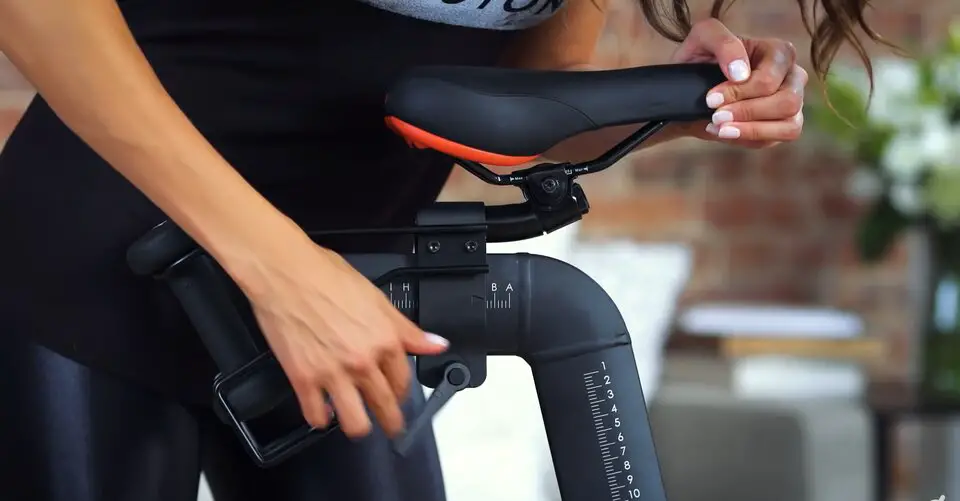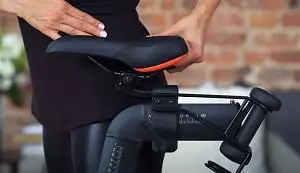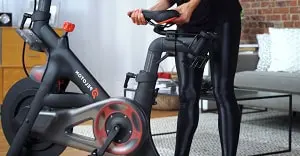Peloton bikes have become a sensation among fitness enthusiasts. If you’re one of them, you might be wondering How To Adjust Peloton Seat.
This article has got you covered!
You Might Also like to Read: How To Change And Remove Your Peloton Bike Seat?
How To Adjust Peloton Seat?

Adjusting your Peloton seat correctly is paramount for a comfortable and efficient ride. The seat’s height, depth, and angle must align with your body’s unique dimensions. Proper adjustment ensures that you’re not straining or compromising your posture, allowing you to focus on your workout.
Incorrect seat positioning can lead to discomfort, fatigue, and even long-term injuries. Therefore, understanding how to adjust your Peloton seat is an essential skill for any user.
The objective of the Article
This article aims to guide you through the detailed process of adjusting your Peloton seat. Whether you’re a new rider or looking to optimize your setup, the following sections provide a comprehensive guide.
From understanding the anatomy of the seat to learning common mistakes, this article will equip you with the knowledge needed to make the most of your Peloton experience.
Anatomy of Peloton Seat
The Peloton seat consists of several critical parts, including the base, cushioning, brackets, adjustment knobs, and rails. The base provides structure, while cushioning ensures comfort during long rides. Brackets hold the seat in place, and the adjustment knobs and rails allow customization.
Together, these components offer support and flexibility, enabling riders to personalize their setup according to their body shape and size.
Each part of the Peloton seat plays a vital role in rider comfort. The cushioning prevents soreness, while the knobs allow for fine-tuning. Rails and brackets ensure stability, giving riders confidence in their bike’s integrity.
The seat’s design takes into consideration the various touchpoints of the human body, resulting in a holistic approach to comfort.
Understanding these elements helps riders make informed adjustments, leading to a more enjoyable workout experience.
Why Peloton Seat Adjustment Matters?

Adjusting your seat to match your body’s proportions promotes comfort during rides. If your seat is too high, too low, or at the wrong angle, you may feel strain or discomfort.
Proper seat adjustment aligns your joints and muscles, allowing for a smooth and natural cycling motion. Comfort translates into longer, more enjoyable rides, motivating you to reach your fitness goals.
Efficiency in Workouts
Seat adjustment directly impacts your workout efficiency. A well-aligned seat enables you to exert optimal power through your legs without unnecessary strain.
This means more energy goes into your workout, rather than compensating for an uncomfortable position.
A properly adjusted seat fosters better alignment, contributing to a more effective and efficient workout.
Prevention of Injuries
An improperly adjusted seat can cause injuries over time. Misalignment places undue stress on your knees, back, and hips, leading to chronic pain and potential long-term damage.
Learning to adjust your Peloton seat properly is not merely a matter of comfort but a crucial step in injury prevention. This section emphasizes the importance of taking the time to ensure your seat fits your body perfectly.
Guide to Adjusting Peloton Seat
Here’s a step-by-step guide on How To Adjust Peloton Seat:
1. Adjusting Seat Height: Position the seat to hip level when standing next to the bike. Check for a slight bend in your leg at the bottom of the pedal stroke.
2. Adjusting Seat Depth (Fore/Aft Position): Ensure that your knee is directly above the pedal axle when the pedals are horizontal. Adjust as needed for even weight distribution.
3. Adjusting Seat Angle: Loosen the bracket slightly, then tilt the seat to your preferred angle. Tighten the bracket securely afterward. A properly adjusted angle helps prevent pressure points.
Adjusting Seat Height

Seat height is a critical factor in achieving a comfortable and efficient ride. Start by standing next to the bike and adjusting the seat to hip level. Then, sit and make sure your leg has a slight bend at the bottom of the pedal stroke.
You can adjust the height using the knob or lever provided. Seat height affects how your legs move during pedaling, and getting it right is vital for comfort and performance.
Adjusting Seat Depth (Fore/Aft Position)
The seat depth, or fore/aft position, should align with your body to allow for proper pedal strokes.
A good rule of thumb is to ensure your knee is directly above the pedal axle when the pedals are horizontal.
Adjusting this positioning aids in balancing your weight evenly across the bike, enhancing stability and efficiency.
Adjusting Seat Angle
The seat angle is often an overlooked aspect of bike setup. If the seat tilts too far forward or backward, it can cause discomfort in the pelvic area. To adjust the seat angle, use the provided tool to loosen the bracket slightly, then tilt the seat to your preferred angle.
Tighten the bracket securely once done. The correct angle promotes even weight distribution and helps prevent pressure points during your ride.
Common Mistakes and How to Avoid Them?
Setting the seat too high can cause overextension of your legs, while setting it too low may lead to inefficient pedaling. Both mistakes can lead to discomfort and injury.
Measure your inseam and consult the bike’s guidelines or a fitness professional to find the optimal height. Regularly check your seat height and make adjustments as needed to maintain the right positioning.
Incorrect Depth or Angle
Depth and angle are equally crucial in seat adjustment. An incorrect depth may lead to imbalances in pedaling, while a wrong angle can cause discomfort.
Pay attention to how your body feels during rides, and don’t hesitate to make small adjustments. Keeping a log of your preferred settings can also help maintain the correct depth and angle over time.
Tips and Tricks for Perfect Adjustment
Finding the right position for your body involves more than just following general guidelines. Every rider is unique, and adjustments should reflect individual needs and preferences.
Experiment with different settings, paying attention to how they feel. Seek professional assistance if needed, as a trained eye can provide insights tailored to your body.
Small tweaks can make a big difference in comfort and performance. Don’t be afraid to make minor changes based on personal preferences. Listen to your body and adjust accordingly.
Remember that what works for someone else may not work for you, so take the time to find what feels best. Keeping a log of these tweaks can make future adjustments quicker and easier.
The Impact of Regular Seat Adjustment
Regularly checking and adjusting your seat helps maintain comfort. Our bodies change, and so should our seat settings. Even small shifts in weight or muscle tone can affect how the seat feels.
Regular adjustment ensures that your seat always aligns with your current physical state, providing a consistently comfortable ride.
Frequent seat adjustments can enhance workout performance. A seat that fits your body perfectly allows for better power transfer, smoother pedal strokes, and greater endurance.
Monitoring and adjusting the seat as needed ensures that you’re always riding in the optimal position, allowing you to perform at your best.
Regular seat adjustments not only benefit you but also reduce wear and tear on the bike itself.
Proper alignment minimizes unnecessary pressure on the bike’s components, extending its lifespan. By regularly checking and adjusting your seat, you’re also preserving the condition of your investment, ensuring many more years of enjoyable rides.
FAQs’
How should the Peloton seat be adjusted?
- Height Adjustment: Your Peloton seat should be adjusted to hip level when you’re standing next to the bike. There should be a slight bend in your knee at the bottom of the pedal stroke.
- Depth Adjustment (Fore/Aft Position): Your knee should be directly above the pedal axle when the pedals are horizontal. Adjust forward or backward as needed to ensure even weight distribution.
- Angle Adjustment: Tilt the seat to your preferred angle, making sure to avoid pressure points. A horizontal position is typically the starting point for most riders.
How far back should my Peloton seat be?
The seat’s depth or fore/aft position should be adjusted so that your knee is directly above the pedal axle when the pedals are horizontal.
This ensures an even weight distribution and prevents strain on your knees. Depending on your body geometry, this may mean adjusting the seat a bit further back or closer.
How do you adjust the forward seat on a peloton bike?
To adjust the forward position of the seat on a Peloton bike, you’ll need to loosen the adjustment lever or knob under the seat.
Slide the seat forward to the desired position, ensuring that your knee is aligned with the pedal axle, and then tighten the lever securely.
How do I make my Peloton seat closer?
Making your Peloton seat closer involves adjusting the seat’s depth. Loosen the adjustment lever or knob under the seat and slide it closer to the handlebars.
As you make this adjustment, ensure that your knee alignment and weight distribution remain optimal. Tighten the lever once you’ve found the proper position.
Additional Resources and Support
For those who need further assistance, many resources and support channels are available. Peloton offers detailed guides, video tutorials, and customer support to help riders with seat adjustments.
Additionally, local fitness professionals and cycling shops often provide personalized services.
Utilizing these resources can simplify the process and enhance your overall Peloton experience.
Conclusion
This article has explored the various aspects of adjusting a Peloton seat, from understanding its anatomy to learning common mistakes.
The key takeaway is that proper seat adjustment enhances comfort, and efficiency, and prevents injuries.
By following the step-by-step guide and tips provided, you can create a personalized riding experience that supports your fitness journey.
Regular seat adjustment is not a one-time task but an ongoing responsibility. As your body changes and your fitness level improves, so should your seat settings.
Regular adjustments ensure that your bike continues to fit you perfectly, promoting enjoyable and productive workouts.
Final Thoughts
The importance of proper seat adjustment extends beyond mere comfort. It’s an essential part of a successful and satisfying Peloton experience. Taking the time to learn and apply these principles will lead to more enjoyable rides, better results, and a deeper connection with your fitness journey.
Whether you’re new to Peloton or looking to refine your setup, these guidelines provide a valuable roadmap to success.
Related Articles:-

